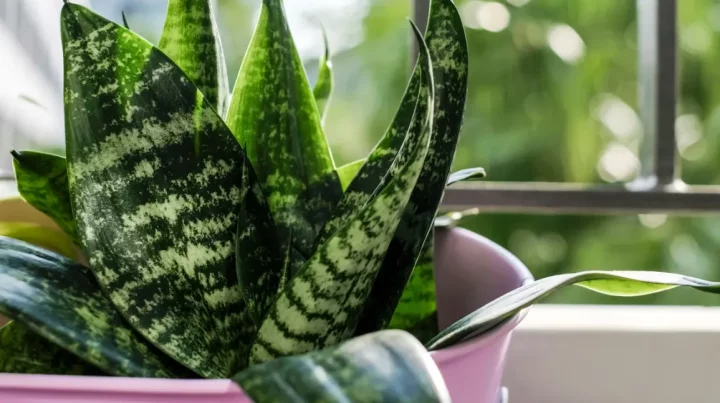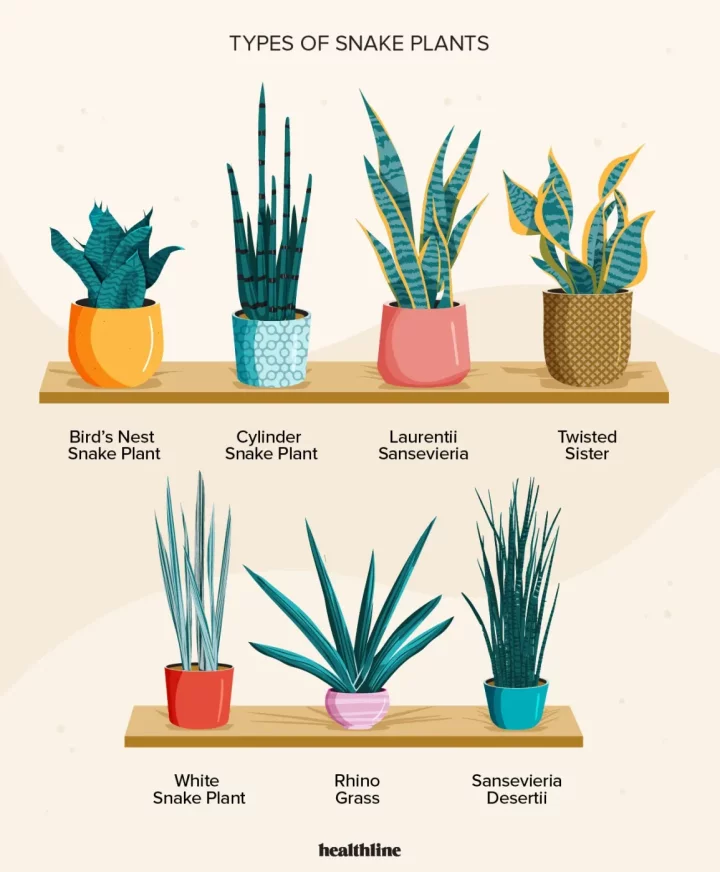In addition to being incredibly easy to grow, snake plants have a number of health benefits, including filtering indoor air, removing toxic pollutants, and boosting mental health.

Many household plants are strategically placed for decoration and to maintain feng shui. But did you know that some of these same plants also have health benefits?
The snake plant is one of those plants known for both looking good and improving air quality.
Keep reading to learn more about the snake plant, its health benefits, and how to care for one.
What is a snake plant?
A common houseplant, the Sansevieria trifasciata is native to Asia and Africa. It can be recognized by its evergreen sword-shaped leaves that grow upright and almost resemble artificial foliage.
Snake plants are often used as home decor since they're pleasing to the eye, are easy to care for, and require little water to survive.
Snake plants are considered to be relatively safe, but they're mildly toxic if consumed. Their leaves contain a poison that can cause swelling and numbness on the tongue if eaten in large doses. It's wise to keep this plant away from children and animals who are prone to nibbling.
Snake plant benefits
The snake plant, commonly referred to as mother-in-law's tongue, is a resilient succulent that can grow anywhere between 6 inches to several feet.
In addition to providing a bit of ambiance, snake plants have a number of health benefits, including:
filter indoor air
remove toxic pollutants
may help boost mental health
easy to care for
effective against allergies
may help enhance the "energy" of a space, according to feng shui
can help with minor ailments
1. Filter indoor air, even at night
Similar to other household succulents, snake plants help to filter indoor air. What's unique about this particular plant is that it's one of the few plants that can convert carbon dioxide (CO2) into oxygen at night.
This quality makes it an ideal plant for bedroom decor, since it can help regulate healthy airflow.
2. Remove toxic pollutants
Snake plants are also known for their ability to help remove toxic air pollutants. In small contributions, snake plants can absorb cancer-causing pollutants, including:
CO2
benzene
formaldehyde
xylene
trichloroethylene
toluene
With the ability to absorb and remove harmful toxins, snake plants may act as an effective defense against airborne allergies.
3. Mental health booster
While the benefits of indoor plants on mental health still warrant further scientific research, the concept that plants play a positive role is well established, according to 2018 research.
Horticultural therapy is even used in mental health treatment, due to its therapeutic effects.
Indoor plants can be added to workplaces, schools, and medical facilities as a low cost and low risk way to improve these environments.
4. Low maintenance and easy to care for
The snake plant is a common houseplant for many reasons. One is that it's so easy to care for.
"Potted Sansevieria plants are common for all continents," explains NatureID botanist Halina Shamshur. "Being very undemanding, they're often grown on windowsills in houses, apartments, and different public buildings."
According to Shamshur, snake plants can tolerate both shade and direct sunlight, underwatering, drafts, and dry air. They also don't require frequent repotting and hardly ever get infested.
5. Effective against allergies
By releasing oxygen and adding moisture to the air, snake plants can help lessen the impact of airborne allergens like dust and dander.
Since poor indoor air quality has been linked to many health-related issues like allergies and asthma, this is a definite benefit.
6. A little feng shui can go a long way
"The Chinese love the snake plant for its ability to absorb negative energy," says Shamshur. "According to feng shui, placing Sansevieria in a classroom facilitates learning."
Shamshur notes that snake plants are believed to absorb negative energies and eliminate bitterness and jealousy. She suggests placing them in a room where people tend to argue or near appliances that emit harmful radiation.
While this isn't backed up by scientific evidence, there's no harm in giving it a try.
7. Relieves minor physical ailments
Shamshur shares that there are numerous other snake plant benefits that aren't scientifically proven but are widely accepted by plant experts.
For instance, snake plants are said to:
heal skin wounds and burns
reduce inflammation
support standard blood pressure
help strengthen the immune system
help flush out parasites
relieve headaches
"You can apply the sap from the plant's leaves to wounds, burns, and inflammation," she says. "Aromatherapy can help you get rid of a headache."
As a reminder, Shamshur says to be careful when using snake plants for healing purposes.
Their leaves contain saponins, which are poisonous substances, in large quantities. Saponins are commonly part of many diuretic, choleretic, and laxative drugs.
Make sure to consult with a doctor before using snake plant for treatment of any symptoms. Never eat or drink any parts of the snake plant.
Types of snake plants

The most common snake plant foliage presents as slender, green leaves with grey or silver horizontal streaks. This plant can grow several feet tall and does well in low light areas.
The Sansevieria genus now encompasses around 70 species, according to Shamshur. A few of the more common types of snake plants include:
Bird's nest snake plant. Also referred to as the Hahnii, this plant is relatively small, growing to only 6 inches tall. The leaves form clusters that closely resemble a cup, similar to a bird's nest.
Cylinder snake plant. The Sansevieria cylindrica has round leaves that can grow several feet in length. The leaves from this plant reach outward to resemble a crown.
Laurentii Sansevieria. The Laurentii is also a popular snake plant, known for its green-colored center and yellow margins.
Twisted sister. The Sansevieria trifasciata "Twist" is a dwarf cultivar of Sansevieria trifasciata and only reaches about 15 inches in height. This hard-to-find plant consists of twisting variegated gold and green leaves.
White snake plant. The Sansevieria trifasciata "Bantel's Sensation" is another unique cultivar of Sansevieria trifasciata. It boasts dark green leaves with white vertical stripes.
Rhino grass. Sansevieria pearsonii is an attractive houseplant that produces a tight clump of vertical leaves.
Sansevieria desertii. Also referred to as Elephant's Toothpick, this plant typically has a fan-like effect.
Caring for a snake plant
Perhaps one of the most popular reasons people include snake plants in their decor is that they're low maintenance, requiring little attention to grow. They're resilient, hardy plants and can survive in relatively dry environments, both indoors and out.
If you plan to have a snake plant in your home, here are a couple of things to keep in mind:
Don't overwater. Too much water is this plant's weakness. Place a snake plant in a well-drained pot to avoid overwatering, as it can cause rotting. Only water the soil when it's completely dry.
Indirect sunlight is best. Partial sun works best for snake plants, though it can still grow in darker corners or in brighter window areas. If completely shaded, the plant can dull and the leaves may become a bit floppy.
How to propagate. Snake plants are not only easy to care for but easy to multiply. Just follow these directions:
Cut off a healthy leaf near its base and make an upside-down V cut at the bottom.
Then, place the leaf in a clean jar of water. Allow the water level to be slightly above the V cut.
Once roots have started to form (3 to 5 weeks), you can keep in water or transfer to soil.
Place a snake plant in a well-drained pot to avoid overwatering, as it can cause rotting. Be sure the pot has a hole to allow draining.
The takeaway
Snake plants are proven to be as useful as they are visually appealing. They can grow indoors and outdoors, with little to no maintenance.
What's more, snake plants can also help filter indoor air, a quality that can keep you safe and healthy. Consider adding a snake plant to your home for both aesthetic and health reasons.

















Comments